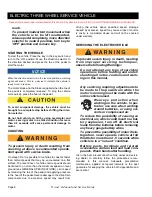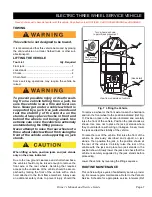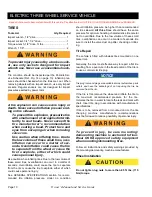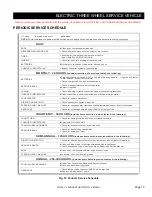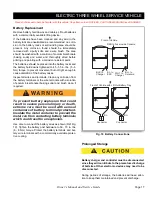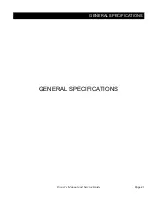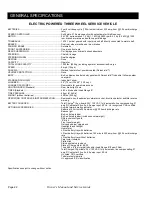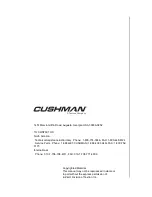
ELECTRIC THREE WHEEL SERVICE VEHICLE
Page 20
Owner’s Manual and Service Guide
Read all of manual to become familiar with this vehicle. Pay attention to all NOTICES, CAUTIONS,WARNINGS and DANGERS.
Using A Hydrometer
1. Draw electrolyte into the hydrometer several times to
permit the thermometer to adjust to the electrolyte
temperature and note the reading. Examine the color
of the electrolyte. A brown or gray coloration indicates
a problem with the battery and is a sign that the bat-
tery is nearing the end of its life.
2. Draw the minimum quantity of electrolyte into the
hydrometer to permit the float to float freely without
contacting the top or bottom of the cylinder.
3. Hold the hydrometer in a vertical position at eye level
and note the reading where the electrolyte meets the
scale on the float.
4. Add or subtract four points (.004) to the reading for
every 10° F (6°C) the electrolyte temperature is
above or below 80° F (27° C). Adjust the reading to
conform with the electrolyte temperature, e.g., if the
reading indicates a specific gravity of 1.250 and the
electrolyte temperature is 90° F (32° C),
add
four
points (.004) to the 1.250 which gives a corrected
reading of 1.254. Similarly if the temperature was 70°
F (21° C),
subtract
four points (.004) from the 1.250
to give a corrected reading of 1.246 (Ref Fig. 22).
5. Test each cell and note the readings (corrected to 80°
F or 27° C). A variation of fifty points between any two
cell readings (example 1.250 - 1.200) indicates a
problem with the low reading cell(s).
As a battery ages the specific gravity of the electrolyte
will decrease at full charge. This is not a reason to
replace the battery, providing all cells are within fifty
points of each other.
Since the hydrometer test is in response to a vehicle
exhibiting a performance problem, the vehicle should be
recharged and the test repeated. If the results indicate a
weak cell, the battery or batteries should be removed
and replaced with a good battery of the same brand, type
and approximate age.
Fig. 22 Hydrometer Temperature Correction
160 71
+.032
+.030
150 66
+.028
+.026
140 60
+.024
+.022
130 54
+.020
+.018
120 49
+.016
+.014
110 43
+.012
+.010
100 38
+.008
+.006
90 32
+.004
+.002
80 27
0
–.002
70 21
–.004
–.006
60 16
–.008
–.010
50 10 –.012
–.014
40 4 –.016
–.018
30 –1
–.020
–.022
2 –7
–.024
–.026
10 –12 –.028
EXAMPLE #1:
Electrolyte Temperature
Above 80˚ F (27˚ C)
Electrolyte temperature
90˚ F (32˚ C)
Hydrometer reading 1.250
1.250 + .004 = 1.254
corrected specific gravity
Electrolyte Temperature
Below 80˚ F (27˚ C)
Electrolyte temperature
70˚ F (21˚ C)
Hydrometer reading 1.250
1.250 - .004 = 1.246
corrected specific gravity
EXAMPLE #2:
˚ F
˚ C
Electrolyte
Temperature

